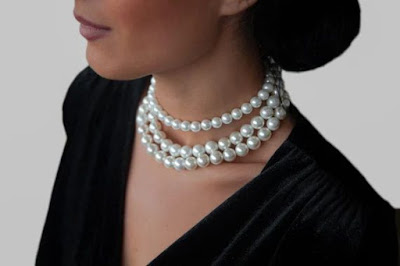3 Most Expensive Pearls in the World
There is a certain elegance to each modern pearl variety. Pearls are a timeless accessory, as said by Jackie Kennedy. The fashion icon's beautiful outfits, which often included pearl necklaces, made a statement no matter the occasion. The current generation of pearl lovers may thank her for encouraging them to accessorize with pearls every time they leave the house.
Related Articles:
Vivienne Westwood Pearl Choker
Vivienne Westwood Necklace Silver
Pearl Necklace With Planet Name Guide
While the first known pearl jewelry was unearthed in the tomb of a Persian king in 420 BC, the oldest known pearl was discovered on Marawah Island, not far from Abu Dhabi, and dates back 8,000 years to the Neolithic era. More evidence suggests that pearls were given as gifts to aristocrats about 2300 BC in what is now China. According to legend, Julius Caesar restricted pearl wearing to the upper class in the first century BC. This is evidence of the historical significance of pearls to human culture.
Pearls from the South Sea
The typical diameter of a South Sea pearl is between 10 and 15 millimeters, making it one of the world's most valuable pearls. They come in a rainbow of hues and may be found in their natural environments of Southeast Asia and Australia. Oysters of the species Pinctada maxima produce these beautiful, one-of-a-kind shades. Oysters that make costly pearls are typically rather little, but this one is so enormous that the pearl it creates is enormous. Because of the rarity and fragility of this kind of oyster, the creation of these pearls is considerably more difficult, and therefore, they are significantly more costly.
The iridescence of South Sea pearls has captivated customers all over the globe for millennia. These pearls are distinguished from others because their nacre coating is often thicker than that of any other pearl kind, giving them a smoother overall look. If you want to be sure you're getting a genuine South Sea pearl, the surface should be perfectly smooth and immaculate.
Pearls of the Akoya variety
When most people think of a traditional pearl necklace, they picture a string of Akoya pearls. Seawater jewels were a big popularity with ancient civilizations because to their silvery white color, spherical form, and moonlike appearance. The Akoya pearl necklace, with its classic design and pure white hue, is now a staple of any serious jeweler's inventory.
The gorgeous round shapes and dazzling reflected luster of Akoya pearls are what set them unique. Nearly a century ago, these were the first cultured pearls to get widespread attention across the world. Smaller than other types of cultured pearls, Akoya pearls range in size from around 6 to 9 millimeters. The price of an Akoya pearl may range from $300 to $10,000 or more.
The world's smallest pearl oyster, the Pinctada fucata martensii, was used to cultivate the Japanese Akoya pearl for the first time in the early 1920s, resulting in a greater supply of affordable, but nonetheless exquisite, pearls for sale across the globe. Pearl farmers insert a tiny bead known as a nucleus into each oyster to encourage the growth of nacre. A pristine, round, smooth Akoya pearl forms over the course of many years when the nacre hardens.
Pearls from Tahiti
Ancient cultures associated Tahitian pearls with the heavens because of their round shape and iridescent sheen. Tahitian pearls come in a broad variety of colors, sizes, and shapes, but the black ones with amethyst, emerald, and silver undertones are particularly symbolic of the moon's shadow.
It's well knowledge that Tahitian pearls have a mysterious, ebony hue. Tahitian pearls naturally have a metallic luster despite their dark color. All of the colors are extracted from the environment. In spite of their lesser size in comparison to South Sea pearls, Tahitian pearls may nevertheless grow rather large, with average sizes ranging from 8 to 14 millimeters.
Contrary to their name, Tahitian pearls are not native to the island nation of Tahiti. The black pearl became synonymous with Tahiti as pearl farmers from all across French Polynesia flocked there to sell their wares. A Tahitian necklace might set you back anything from $500 to over $25,000.
Concluding Ideas
Pearls discovered in the wilds of the ocean are called natural pearls. Divers who specialize in harvesting oysters scour the ocean floor for valuable artifacts. Pearl farming is used to create cultured pearls. Despite being more common than real pearls, these pearls are nonetheless authentic in every way.
Diving for natural pearls has been going on for decades, and as a consequence, these gems are now so rare that their possible extinction has been raised. The decline in their numbers means they are now very hard to find at sea level. This difference in cost between natural and cultivated pearls is mostly attributable to the former's rarity.




Comments
Post a Comment